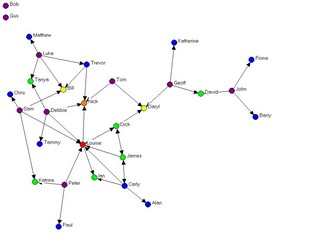Blog
Subscribe
Join over 5,000 people who receive the Anecdotally newsletter—and receive our free ebook Character Trumps Credentials.
Categories
- Anecdotes
- Business storytelling
- Collaboration
- Communication
- Corporate Storytelling
- Culture
- Decision-making
- Employee Engagement
- Events
- Fun
- Insight
- Leadership Posts
- News
- Podcast
- Selling
- Strategy
Archives
- April 2024
- March 2024
- December 2023
- November 2023
- October 2023
- September 2023
- August 2023
- July 2023
- June 2023
- May 2023
Years
How do you design your questions for a Social Network Analysis?
One of the key components to a social network analysis (SNA) is the designing of the questions.
Here are some examples of some questions often used in SNA*:
- Whom do you typically turn to for help in thinking through a new or challenging problem at work?
- Whom are you likely to turn to in order to discuss a new or innovative idea?
- Whom do you typically give work-related information?
- Whom do you turn to for input prior to making an important decision?
- Whom do you feel has contributed to your professional growth and development?
- Whom do you trust to keep your best interests in mind?
These listing of questions reflect all kinds of qualities like trust, communication flow, problem solving networks etc.
You can face a real dilemma however, if, once having designed the questions you get feedback like “we are not sure this survey should go across our teams” or even worse “ we don’t feel comfortable revealing our names in this survey so we would like to make it anonymous”.
Such problems bring up a really good, but maybe often overlooked point. How the group will actually make sense of your wonderful SNA questions? One approach to this conflict may lay in the use of our Power Law. Simply raise the power of the group that you are working with. Involve them, collaboratively, in a discussion around the design of the social network analysis.

(*-See The hidden power of social networks )
About Andrew Rixon
Twitter •
Comments
Comments are closed.
The key thing is that an SNA is consensual visualisation of social relations. Which begs the question as to how you go about manufacturing/nuturing that consensus. One approach is to strive for objectivity. Another is to part the development of the questions iterative.
A key factor is often the scale of the SNA – 20 people is a very different kettle of fish to 150…
Thanks Matt.
Your right about the scale. Most meeting formats with the exception of open space would find 150 people stressful.
Another way to collaboratively develop the social network questions for large groups can be to use an online delphi approach. A delphi approach is great for distributed networks as well as providing a great collaborative platform.
One thing to watch of this approach is that, as online facilitator, not to get bogged down with data processing. Formal delphi processes have some pretty hardcore statistics. I’ve found that simple quantitive trends can be insightful. eg. 19% raised this issue, 25% raised this issue…
Cheers,
Andrew
How often would you actually see this dilemma, though?
Looking at the Power Law, I see what you’re getting at, but it does depend (especially in an online context) on everyone buying in to the process – otherwise they will be, literally or figuratively, looking at their shoes and keeping quiet. Especially when, as a consultant, you’ve been brought in by management but the staff don’t see what they are getting out of it….
In that case, I guess you have to have already educated the participants, and issues like the ones you raise would be part of the process. So, I suppose education about the reasons for, and benefits of, the analysis, (perhaps at a very early stage before the questions are even drafted) would increase willingness to share, and avoid the dilemma?
Hi Emlyn,
Thanks for your comments.
I agree. Participatory approaches are a powerful way to reduce the power gradient while at the same time building awareness around the program.
Or, as Benjamin Franklin once said:
“Tell me and I forget. Teach me and I remember. Involve me and I learn.”
Warm regards,
Andrew